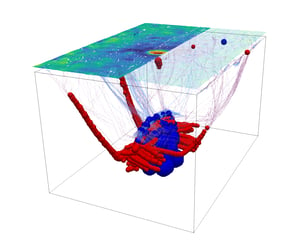The Generation of Equivalent Sources by 3D Skeletonizaton of the Migration Density Field
Summary
An iterative method of fitting equivalent sources to gravity gradient data will be presented in this paper. The purpose of doing this is to rapidly transform Full Tensor Gravity Gradiometry (FTG) data into an approximate 3D model of the source density. This paper will be most relevant to those wishing to get the maximum information out of their FTG data and those developing new methods of processing and interpreting FTG data.
On each iteration, only a small subset of the final source distribution is fitted using a skeletonized version of the tensor migration density used to position them. The incremental field due to the sources is calculated and subtracted from the residual gravity gradient observations after finding the best fitting density value. The process repeats until there is no longer any significant reduction in the residual amplitude.
Results showing the utility of this method for noise reduction, filtering and depth separation will be presented.

Figure of FTG survey and its skeletonized equivalent source
A 3D representation showing a cutaway map of Tzz over the Vinton, Louisiana salt dome, and its skeletonized equivalent sources. Positive density contrast sources are shown in red, negative density contrast sources are shown in blue. The dominant features visible are a large deep negative density contrast (blue) due to salt and a concentrated shallow positive density contrast source (red) due to near surface cap rock.
Key Takeaways
- An algorithm is demonstrated that iteratively generates a sparse, 3D set of equivalent sources for processing gravity gradient data.
- The location of the sources is determined by calculation of the migration density field.
- Compression of this input is achieved by skeletonization, the calculation of the 3D medial axis.
- Open source software tools can be used to efficiently execute this calculation.
- This method is beneficial in that it rapidly transforms FTG data into an approximate 3D model of the source density.
Presented Tuesday, 30 August 2022 in the GM 1 Inversion Insights Session | 10:20 to noon | Location 371
